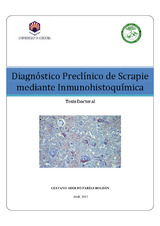Diagnóstico Preclínico de Scrapie mediante inmunohistoquímica

Ver/
Autor
Farias Roldán, Gustavo Adolfo
Director/es
Pérez Arévalo, JoséZafra Leva, Rafael
Editor
Universidad de Córdoba, Servicio de PublicacionesFecha
2013Materia
ScrapieOvinos
Caprinos
Enfermedades neurovegetativas
Chile
Diagnóstico
Histopatología
Inmunohistoquímica (IH)
METS:
Mostrar el registro METSPREMIS:
Mostrar el registro PREMISMetadatos
Mostrar el registro completo del ítemResumen
El scrapie clásico producido por priones, es una enfermedad
neurodegenerativa fatal que afecta a ovinos y caprinos, caracterizada por
presentar un largo periodo de incubación, posterior a lo cual es posible el
diagnóstico con la aparición gradual de los signos clínicos y las alteraciones
neurológicas. La principal vía de transmisión entre los animales es la oral.
En Chile el scrapie no ha sido descrito, por tanto, al tratarse de una región con
baja probabilidad de encontrar animales enfermos, los sistemas de vigilancia
para esta enfermad son de tipo pasivo, acotándose al muestreo post mortem
de cierto número de animales, principalmente los que muestran sintomatología
clínica compatible. Para esto se cuenta con herramientas diagnósticas como
son la histopatológica tradicional y la inmunohistoquímica (IHQ). El gran
inconveniente es que se utilizan muestras de cerebro, por lo que éstas deben
ser obtenidas post mortem. Este hecho impide detectar la enfermedad en
animales que pueden estar incubándola sin presentar la sintomatología,
impidiendo así su manejo adecuado.
En este trabajo se analizó, implementó, aplicó y validó un método para detectar
scrapie clásico en su etapa preclínica, utilizando la IHQ en muestras de tejido
linfoide, tanto del tercer párpado como de la mucosa rectal de ovinos. De
acuerdo con lo descrito, esta técnica permitiría realizar el diagnóstico en la fase
preclínica de la enfermedad en poblaciones ovinas amplias, permitiendo
realizar el diagnóstico en animales vivos y desarrollar estudios conducentes a
establecer un estado comprobable del scrapie en la masa ovina nacional.
Por una parte, se obtuvieron y procesaron 86 muestras de tercer párpado de
ovinos nacionales, 44 obtenidos de mataderos y 42 procedentes de animales
con sintomatología nerviosa compatible con scrapie. Por otra parte, se
analizaron 100 muestras de mucosa rectal distal de ovinos de mataderos, todos
ellos entre los 2 a 4 años de edad. Además se utilizaron muestras ciegas de
validación, 14 de tercer párpado y 12 de mucosa rectal, con sus respectivos... The classical scrapie produced by prion is a fatal neurodegenerative disease
that affects sheep and goats, characterized by a long incubation period, after
which the diagnosis is possible with the gradual onset of clinical signs and
neurological disorders. The main route of transmission between animals is oral.
In Chile scrapie has not been described, therefore, being a region with low
probability of finding sick animals. Surveillance programs for this disease are
passive using postmortem sampling of a number of animals, mainly those
showing clinical signs compatible with the disease. The main diagnostic tools
are traditional histopathological and immunohistochemistry (IHC). The big
drawback is that brain samples are used, so they must be obtained post
mortem, which does not allow to detect the disease in life animals that may be
incubating the disease and that do not show clinical signs, and their proper
handling.
In the present work we analyzed, implemented, applied and validated a method
for detecting classical scrapie in the preclinical stage, using IHC in lymphoid
tissue samples from both the third eyelid and the rectal mucosa of sheep.
According to the description, this technique would make the diagnosis in the
preclinical phase of the disease in large sheep populations, allowing the
diagnosis in live animals and conduct studies to establish a state conducive
verifiable sheep scrapie in the National sheep population.
In a first step, were obtained and processed 86 samples from domestic sheep
third eyelid, 44 and 42 obtained from slaughterhouses and from animals with
nervous signs compatible with scrapie. Moreover, 100 samples from distal
rectal mucosa of sheep slaughterhouses, all of them 2 to 4 year-old were
analyzed. Furthermore 14 blind samples from third eyelid and 12 from rectal
mucosa, with their respective obex were used for validation purposes. 37
samples from sheep obex provided by a Reference Centre (RC) were used as
positive and negative controls for the IHC...
